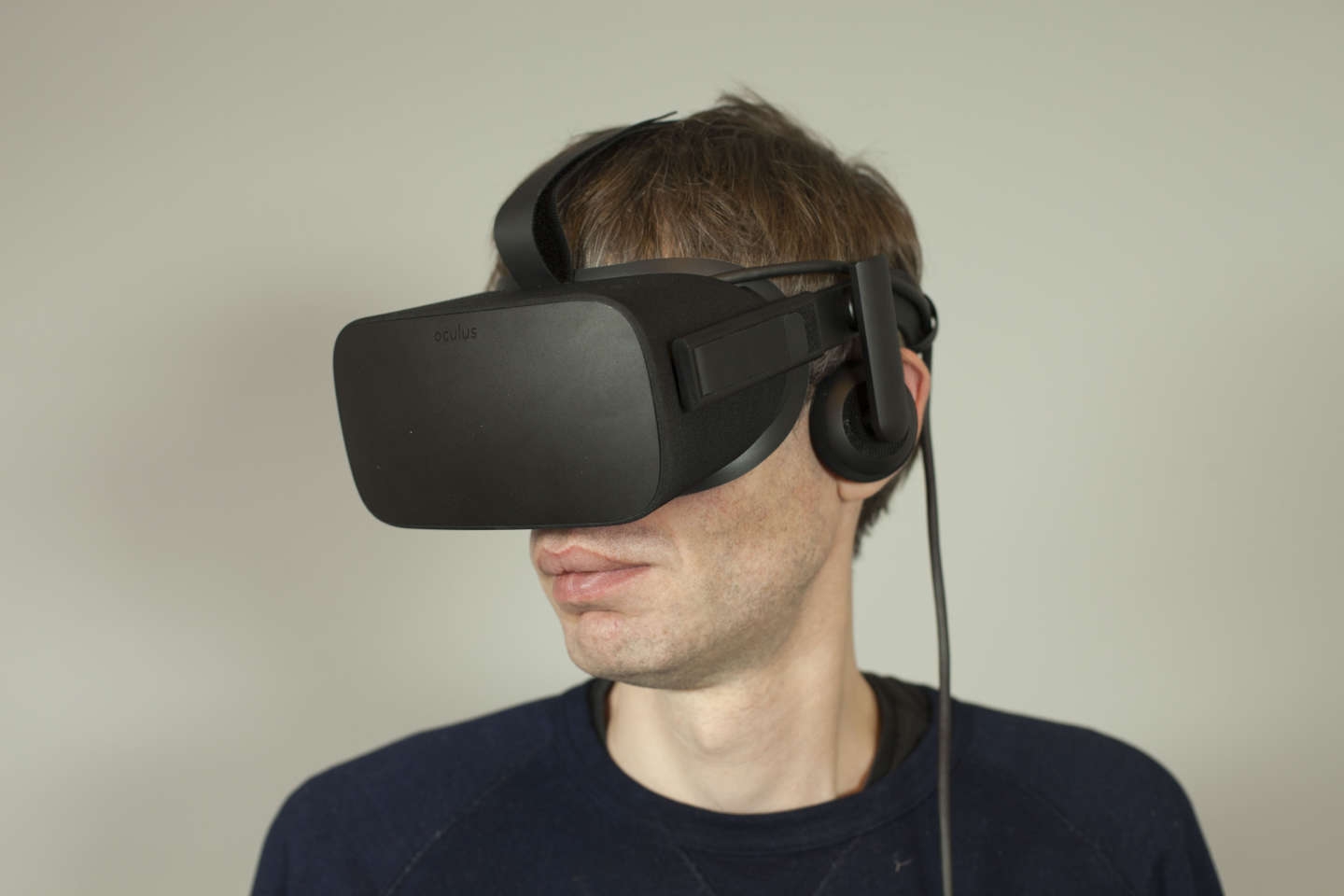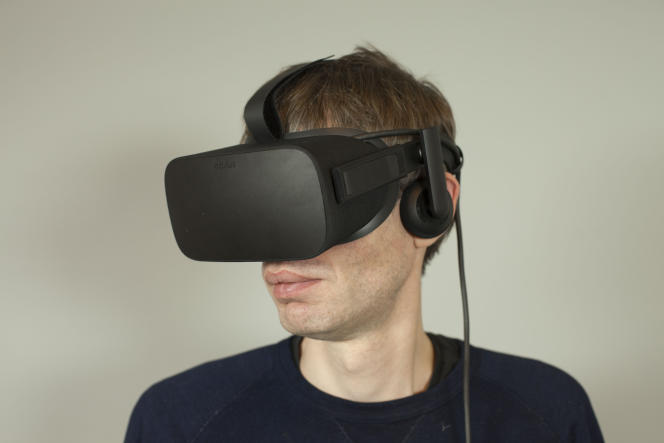The disappointing figures of virtual reality make the pros of the video game doubt

 The Oculus Rift is a virtual reality headset released in March 2016. PIERRE TROUVÉ / THE WORLD
The Oculus Rift is a virtual reality headset released in March 2016. PIERRE TROUVÉ / THE WORLD
“Personally, I don’t believe it anymore,” admits Jean-Yves Lapasset, from SEGA Europe. Within the video game industry, part of which was gathered, from Wednesday, May 10 to Friday, May 12, at the Videogames Economics Forum in Angoulême, the look at virtual reality is increasingly critical. Five years after the spectacular financing of the Oculus Rift headset on Kickstarter, the indicators are in orange, and the orientations of the main manufacturers rather contradictory.
Worrying indicators
Facebook, responsible in 2014 for the spectacular takeover of Oculus VR, a pioneer company in the sector, seems to have taken a step back regarding the chances of success of its homemade headset, the Oculus Rift. Its sales are estimated at less than 500,000 pieces in a year. At the same time as the firm launched Facebook Spaces in April, its virtual reality communication software, Mark Zuckerberg announced that his company was now betting on augmented reality, a completely different technology, which consists of adding computer visual elements into reality and not to lock itself in a virtual world.
Even more surprising, on the PS VR side of the PlayStation 4, Sony announced that it had exceeded its objectives, 915,000 copies in just four months, but its peripheral is difficult to find, the Japanese manufacturer almost no longer communicates on it and has even closed one of its specialized development studios, a decision that took many observers by surprise. Is it because behind the encouraging figures of his helmet, those of his use are disappointing?
On Steam, Valve’s video game platform, in April, the proportion of monthly users of VR devices stood at only 0.23% of the total players. Even more worrying, this proportion was even down, even if it was minimal (-0.1 percentage points), for the first time since the introduction of these devices in 2016. One of the most popular titles, Heaven Island, has about 250,000 installations, according to the count of the Steam Spy website, for an average playing time of only five minutes. “This is the kind of product that we buy, that we try, then that we put away and that we only come out to show it to our friends,” analyzes Gil Doukhan, venture capitalist at Iris Capital.
A few hundred connected players
For a long time, the industry circulated the idea that nausea affected a small part of the population in a congenital way. The reality is more embarrassing. “80% of gamers feel nauseous the first time they try virtual reality,” estimates Samuel Auzols, from Raptor Lab. A show of hands survey among the VEF audience, mainly composed of professionals experienced in extreme experiences, will not be much more reassuring: more than half admit to having experienced discomfort one day while playing in VR.
The other problem of the virtual reality market is its disproportionate number of available games compared to the number of actual users. On Steam, there are already 830 compatible games that are competing for a tiny cake for now. Most of the other securities have only a few thousand, or even hundreds of buyers. The most popular of the paid multiplayer games, Space Pirate Trainer, recorded, at its highest, a peak of 120 simultaneous players, testifies one of the few to play it, Etienne Rouzet, from the Aggro Consulting agency.
This is the reason why, apart from Sony, the giants of the sector remain relatively behind. “Most of the big studios are not launching too much, because it is still an emerging market and it is not worth it for them to put millions into it,” says Samuel Auzols, from Raptor Lab, a French video game studio that has developed a technology to move in virtual reality without moving.
Four million investments in France
This abundant catalog is a direct result of the deliberately optimistic speeches that preceded the launch of the technology for five years. In the United States, venture capitalists have abundantly financed video game projects, relying on the lightning collaborative financing of the Oculus Rift on Kickstarter, in 2012, and the belief that it would be launched at a much lower price than it actually was – more than 700 euros, excluding compatible computer.
The World
Special offer for students and teachers
Access all our unlimited content from 8.99 euros per month instead of 10.99 euros
Subscribe
In France too, VR has drained hopes and funding. Four million euros have been invested in virtual reality projects for the past two years, according to Pauline Augrain, head of the digital creation department at the National Center for Cinema and the Animated image (CNC). At the Cnam national school of games and interactive digital media (Enjmin), a prestigious video game school located in Angoulême, there are also many student projects in virtual reality.
But a year after the launch of the Oculus Rift and the HTC Vive, it suddenly blows very cold. On the Kickstarter collaborative platform, the number of projects reaching their funding goal is falling, and the number of new submissions is also falling. “We feel that the runaway period has passed,” summarizes Thomas Bidaux, from the consulting company Ico Partners. And for their part, venture capitalists are starting to lose patience: “We are all watching what is happening in virtual reality, but so far, no one has managed to prove that there is money to be made,” notes Gil Doukhan.
How virtual reality plays with your brain (for better and for worse). BERNARD MONASTEROLO
The hypothesis of slow adoption
Despite these poor indicators, some want to believe in a very long-term success, such as Laurent Michaud, from iDate, who warned at the end of 2016 that due to their price, virtual reality headsets would only be adopted slowly. Only 15.6% of American households will own one by 2020, the firm estimated at the time. “We have the feeling that there has been far too much excitement, which has led to overestimating the potential of this market in the very short term. We are convinced of the impact that this technology will have on uses, but it will take time. “And that the size of the helmet, the adverse effects and the prices decrease. For Laurent Michaud, the psychological price would be 150 euros; “we are still far from counting”.
One player has, in any case, an interest in seeing VR develop: Microsoft, whose Windows environment is currently the only one to run all high-end models, namely the Oculus Rift and the HTC Vive. The Redmond firm also took advantage of its Microsoft Build 2017 conference to present mid-range Acer and HP headsets, compatible with the latest Windows 10 update, and at a more affordable price than the competitors currently available, around 400 dollars (365 euros).
Microsoft presented, at Microsoft Build 2017, a mixed reality headset signed Acer. MICROSOFT
Microsoft is also planning an online game mixing virtual and augmented reality. The manufacturer is also due to present the next evolution of its console, the Xbox Scorpio, at E3, the video game fair scheduled to be held from June 13 to 15 in Los Angeles (California). “We plan to introduce mixed reality content in 2018 on devices from the Xbox One range, including the Scorpio,” warned the firm at the beginning of the year. For its part, joined by The World, Sony evokes several releases of “games and applications” – such as the shooting game Farpoint, this Tuesday.
It remains to be seen if the video game industry will eventually find its way, or if it is another sector that will benefit from these technologies so much highlighted. “For the moment, no game has been very successful, it’s true, admits Julien Villedieu, from the National Video Game Union (SNJV). We notice that the recipes are often those of old games, that they work poorly, and that there is a vomiting effect. But there are interesting applications when it comes to audiovisual and interactive experiences. »
For his part, Gil Doukhan is interested in a very specific economic model: that of ticketing for broadcasts of shows and concerts in virtual reality.








